Building a James Bond Boat
Scott Hershey on building his Glen-L Malahini called "Lucille"
No one was surprised to learn I was building another boat—at last count this would be my ninth (or is it tenth?). The surprise was I was building a powerboat. For the past thirty years, after all, my workshop and every spare hour had been dedicated to a series of wooden sailboats: a sweet Haven 12-1/2 named Deborah Lynn (after my wife, to keep the peace), a 25‘ Cape Cod catboat named Lazy Lucy because of her “wine & cheese” cruising disposition, a modified Chesapeake Light Craft Pocketship named Perfecto which was purportedly my last building project, a Nutshell Pram dubbed Nice Boat for lack of imagination, a dinghy or two, a couple of kayaks, and a stand-up paddleboard.
And then I happened across the Glen-L boat builders’ page on Facebook and a gleaming little runabout called the Malahini. Further scrolling revealed several incarnations of the vessel—some completed, others in in various stages of construction at the hands of builders from all over the map, both in terms of geography and building proficiency. So classy and nostalgic, so reminiscent of the 50’s-era Chris Craft and, taking seduction to the next level, similar in downright sex appeal to the iconic Italian masterpiece, the Riva, I knew there was no turning back. I ordered the plans and cleared space in my garage.
The appeal of the Malahini went beyond the aesthetics. I have always loved the art of sailing, both the challenge and the tranquility of it. But, maybe because I’m getting older, the particulars of sailing—from the preparation to launch, stepping the mast and adjusting the rigging, to then being at the constant mercy of wind and weather--were starting to feel more and more limiting to me. The Malahini conjured visions of both Henry Fonda nimbly tucking in and out of sylvan coves in “On Golden Pond”, and James Bond zipping around the Riviera at the drop of a hat. It was time for a change.
The 16’ Malahini was my choice, trailerability and readiness-to-launch being priorities, and I favored the building technique—fiberglass over ply. I was happy to find the Glen-L plans easily modifiable, as I had in mind a few design “tweaks,” the first being ergonomic. I shortened the floor under the console to allow about four more inches of depth of legroom, comfort being another big priority. Since this change actually simplified the build a bit while allowing those in the front seats a more comfortable sitting position, I have wondered why anyone would choose to do it any other way. I also widened the pass-through between the front seats and integrated handy custom storage compartments behind the seats.
Spoiler alert: our first boating season is in the books, and both of these modifications earned unanimous “thumbs up” from passengers and crew.
Looking ahead, I researched the type of motor which would best suit Lucille and settled on a 4-cycle, 60 HP Mercury Command Thrust (CT). Since the vintage runabouts which inspired the Malahini were mostly equipped with much lighter 2-cycle motors, the 20-gallon fuel tank was tucked away in a compartment behind the rear bench seat. Considering the 250 pound 60 HP Mercury, a couple of passengers, and a 20-gallon tank of fuel might render Lucille somewhat back-heavy (too much “junk in the trunk,” you might say), I reasoned that by moving the fuel tank to the front of the boat it would allow a better load balance. I installed the fuel tank neatly under the foredeck instead, with removable access panels for maintenance, and positioned the fuel-filler neck and hardware conveniently above it.
This opened up new storage possibilities for the space behind the rear bench seat. Even with the main battery housed in that compartment, there is plenty of room for several life vests and other essentials, such as a blanket and a picnic lunch. Further addressing functionality, I chose to fabricate a pop-up lid with pneumatic supports, since the large lid can be heavy and cumbersome.
Functionality and aesthetics were top of mind while planning Lucille’s build, and I gave a great deal of thought to the concealment, security, and accessibility of the boat’s wiring harness and steering cables. I fabricated mahogany ceilings to run the length of Lucille’s interior port and starboard, integrating access panels, and secured the wiring high inside, thereby improving the odds of both keeping the cables dry, and Lucille’s cabin clutter-free. The added elbow rests were just the right depth to accommodate stainless steel cupholders, also essential hardware. Similarly, the house/navigation wiring and battery are safely concealed in a small console between the front seats, the face of which serves as one of the boat’s instrument panels for the bilge pumps and running and interior lights. The little console comes complete with—what else—another stainless steel cupholder.
Another goal was to replicate the vintage runabout’s pleasing instrument panel as closely as possible. With a little luck and a lot of scouring eBay, I was able to procure a genuine MerCruiser dash panel gauge cluster, circa 1958, which I then upgraded to accommodate modern electronic gauges for fuel, RPMs, engine temperature, battery levels, docking lights, and a horn button. The final result was perfect, exactly what I had hoped for.
I wasn’t fully prepared for the reaction of passersby while Lucille rested at dock this past summer. Much like having a supermodel on your arm, or at least that’s how I imagine it. Having built several other boats, there were always folks who recognized and revered hand-built boats, both the design and the scale of the projects. But Lucille enjoyed another level of attention; It was pretty clear she had the “wow” factor.
I attribute much of her allure to the treatment of brightwork. While the Glen-L plans do not specify planking details of the foredeck or floor of the Malahini, I knew from the start the look I was after. I began the process of planking by sealing several 4’ x 8’ panels of ribbon-striped Sapele marine plywood with epoxy and a couple of coats of Pettit’s 1015 Captain’s Varnish, sanding well between coats. Then, I cut 40 or so 2”x 8’ strips and covered the top surface of each strip with painter’s tape. I then embedded these foredeck strips in epoxy which had been applied to the subdeck, using 1/4” tile spacers and working from the center out. After the epoxy had cured, I filled the spaces with a few applications of beige-tinted epoxy. After that cured, I removed the tape, sanded the surface well, and applied seven coats of the Captain’s varnish, of course, sanding well between coats. The result was a monolithic deck surface, the beauty and depth of the wood highlighted through the layers of varnish. Lucille’s floor was planked similarly, but with black Sikaflex Marine Caulk applied between the strips instead of epoxy, and no additional coats of varnish, optimizing traction and safe footing. While still striking in appearance, it is less like a skating rink surface when wet.
Without question, my favorite modification to the basic Malahini plans is the integrated wishbone-shaped toerail. I have had a crush on the Italian Rivas since I was seventeen years old, and this feature, carved from solid mahogany and enrobed in layers of honey-colored varnish is my homage to that “Ferrari of motorboats.” No doubt Lucille would have been a looker without this elegant accessory, but the Riva influence, in my opinion, kicked her snazziness up a notch.
I might mention here that my day job is making and repairing violins. The reverence for wood, the passion for carving and shaping and finishing wood has been at my core my entire life. Many have expressed curiosity at the violin/wooden boat connection, but it makes perfect sense to me. The graceful lines of a violin, the sheer genius of design, and the miracle of forming a piece of art from rough cuts of wood with my own hands is not so different from building a boat. Vastly different uses, admittedly, but very similar in so many other ways.
In an effort to express my love for both my vocation and avocation, I’ve included a “violinish” detail in every one of the boats I’ve built, and Lucille is no exception. Most people stop to acknowledge her beautiful, sporty lines, the gleaming brightwork, and her romantic, vintage persona. Upon closer inspection, the carved mahogany violin scrolls that support the wooden window frame always brings a surprised smile, and the connection is made.
It took about two years to build Lucille. I found the plans straight forward—I think a first-time boat builder would find the project challenging, but, with basic skills and a lot of grit, not impossible. And while the plans furnish a list of suggested materials, there is leeway in choosing materials with an eye on budget considerations. For example, I splurged on Sapele marine plywood over lesser-grade plywood, because of its proven strength and durability for the frames and sheeting, and I sprung for custom-made stainless steel cutwaters. On the other hand, Lucille’s stainless steel rub rails were repurposed, having lived a former life along the hull of a sailing schooner on the Outer Banks of North Carolina. With a little resourcefulness, the possibilities are endless.
Granted, my woodworking experience afforded me a bit of an advantage in the construction of the Malahini, but that’s not to say I didn’t encounter a couple challenges, neither having to do with wood. First, the wiring. I will say I am no electrician, but after a bit of head-scratching, trial and error, and as my granddaughter says, “consulting the YouTubes,” I puzzled it out.
The other challenge was upholstery. Lucille was finished, but she was not fully dressed, and custom upholstery was clearly not in the budget. The problem was, I had envisioned her with the same sweet upholstery treatment as the original runabouts. While my sewing experience was limited to the construction of a few sails and boat covers, I broke out my old Sailrite machine and sought out the tutorials. Frustration ensued (along with a lot of bad language), but after the dust settled, Lucille was ready for the prom.
Launch date was July 1st, 2022. I’ll admit to being a little nervous—maiden voyages are uncertain at best; add to that my inexperience at piloting motorboats.
Since we had spent much of our sailing time on the Roanoke Sound over the past decades and were comfortably familiar with the water, we trailered Lucille the 400 miles down I-95 from Pennsylvania to Manteo, North Carolina, where we enlisted the help of some dear friends to whom life on the water in a powerboat is second nature. By all accounts, Lucille’s maiden voyage was a rousing success.
With a full season behind us, I am delighted to report I could not be happier with the way Lucille handles. She jumps up on plane quickly and maintains an optimum high speed of 30 mph with four passengers, without breathing hard. She’s as spry and agile as a little sports car. A word of caution, however: the Malahini performs best on calm waters. Even the slightest chop will send spray over the bow, causing your drenched passengers to be less than polite. A lot of chop will cause the flat hull to slap alarmingly.
What’s next, now that I’ve finished my second “last boat”? My tried and true sailing PocketShip, Perfecto, stands at the ready, having been relegated to my backyard. While sailing adventures are not off the table, more and more I picture myself in the roll of Norm Thayer (“On Golden Pond”), or James Bond, depending on Lucille’s mood.
Many, my wife included, suggest dedicating more time to actually using my boats, as opposed to building them, but I don’t know. There’s always time for one more “last boat.” •SCA•

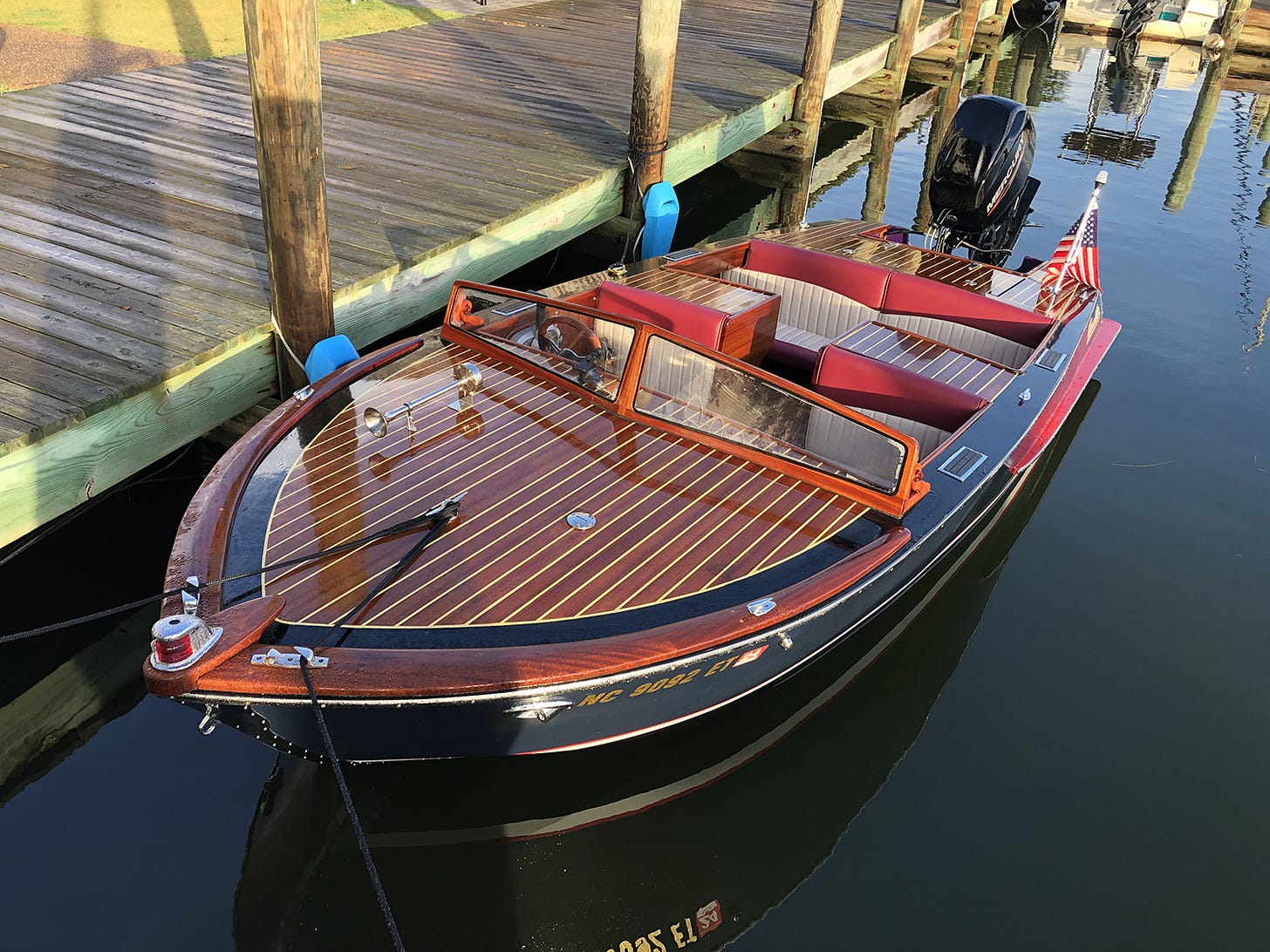

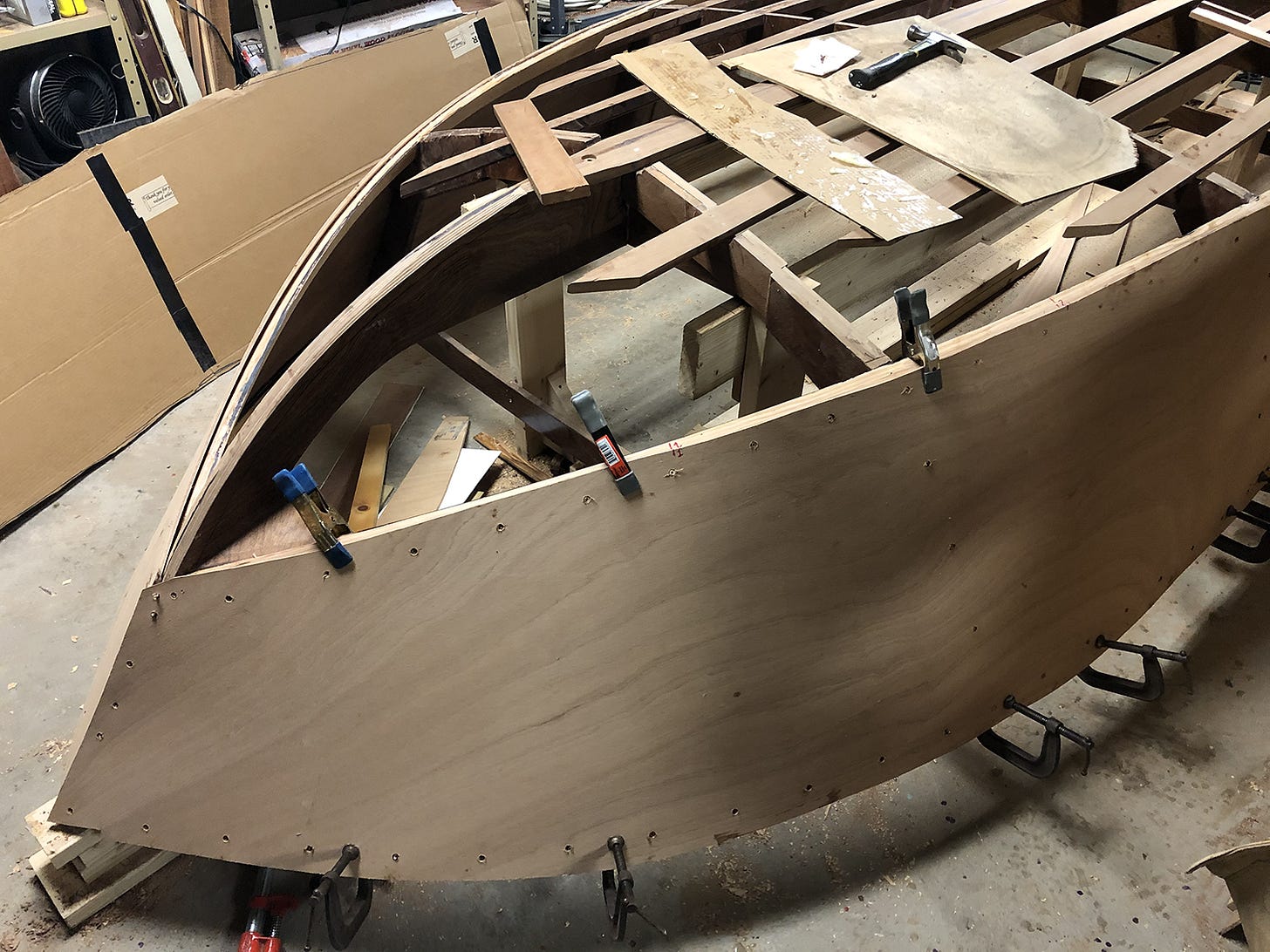




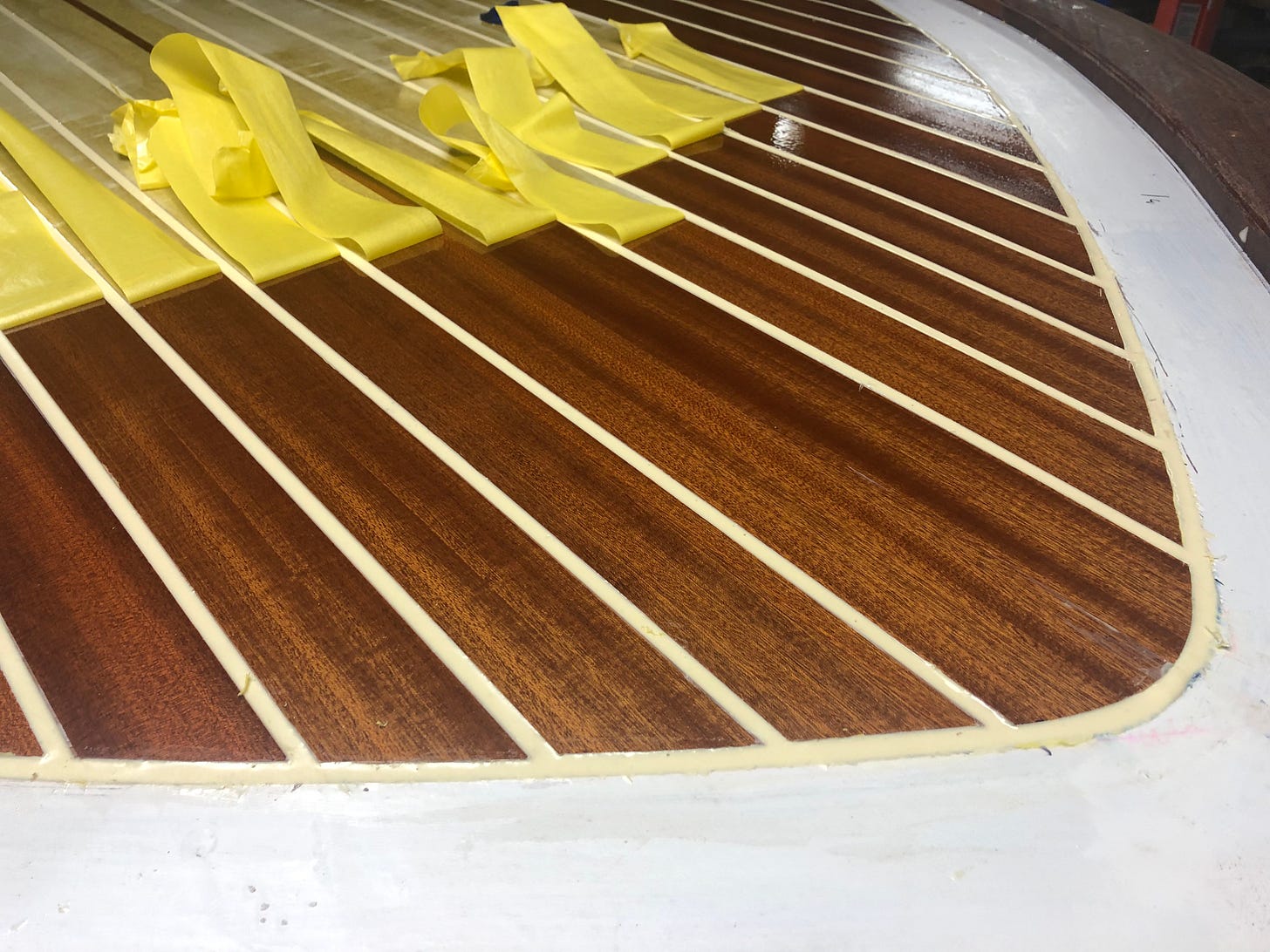

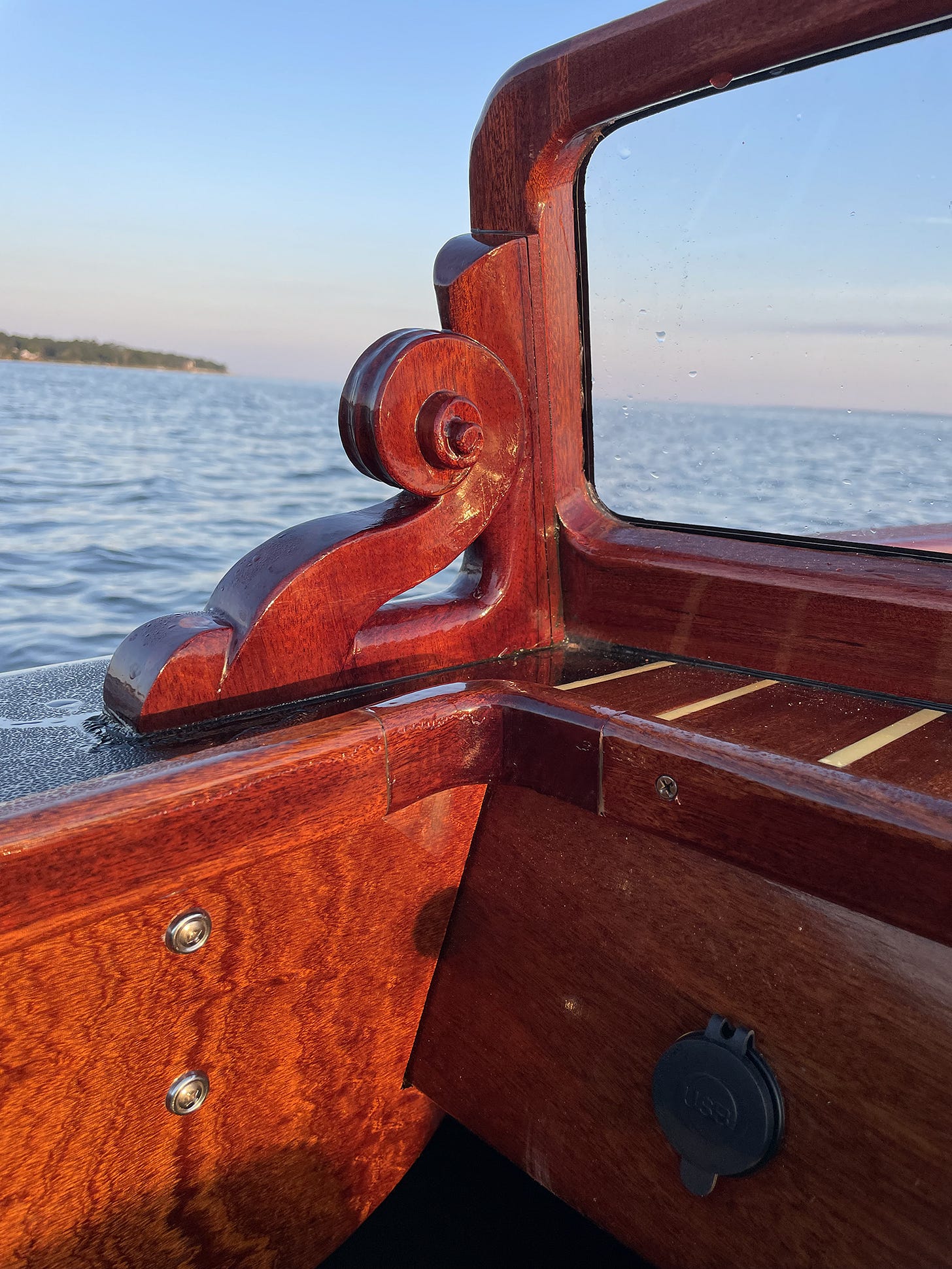

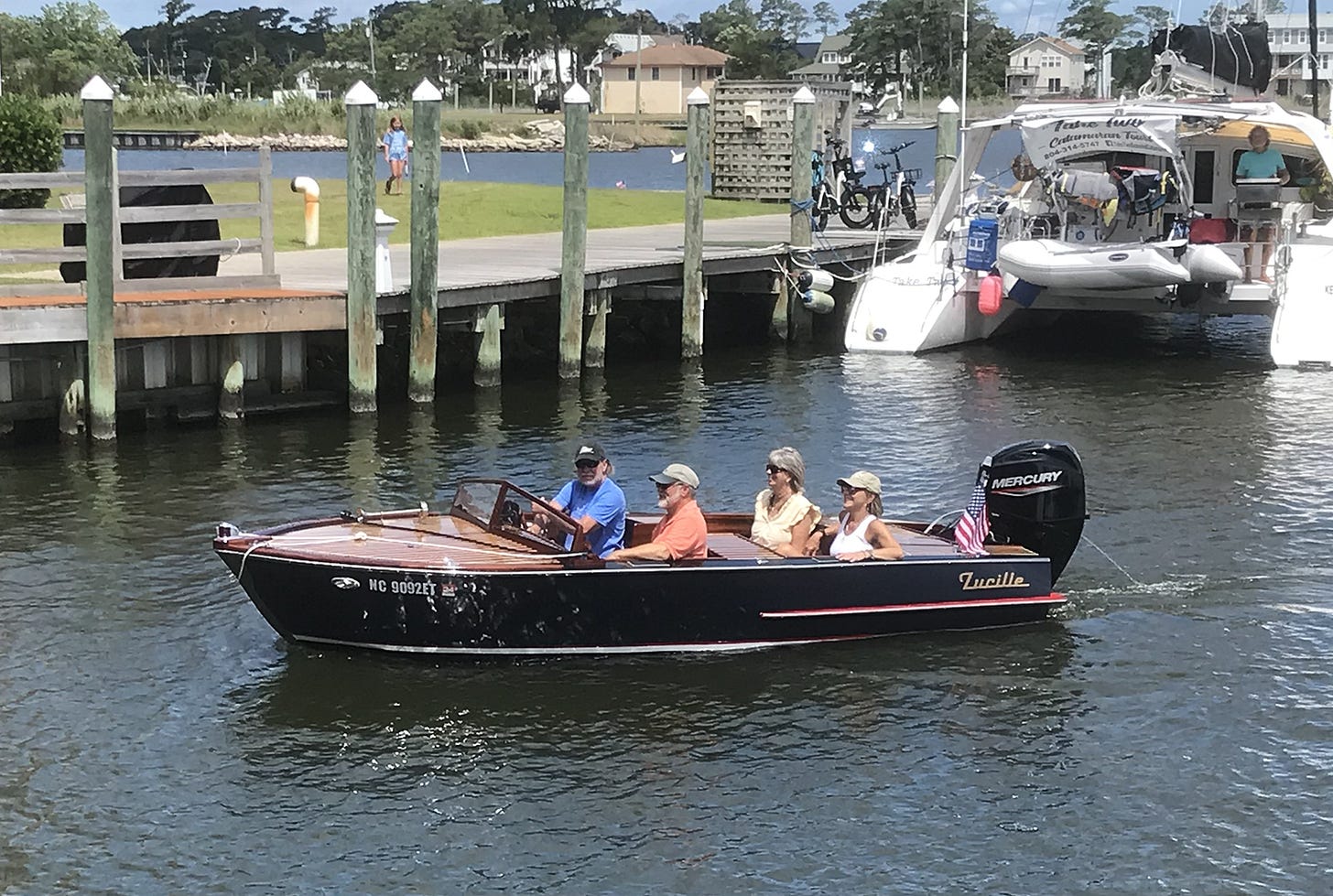
Great looking craft. So well done. Thanks for allowing me to board her this past summer in Manteo. I am building the Glen-L Party Boat and hope to incorporate some of your design wisdom in her.
Ranny
Building boats is an incurable disease. I am sure I will die with a plane in my hand trying to get a fair line.